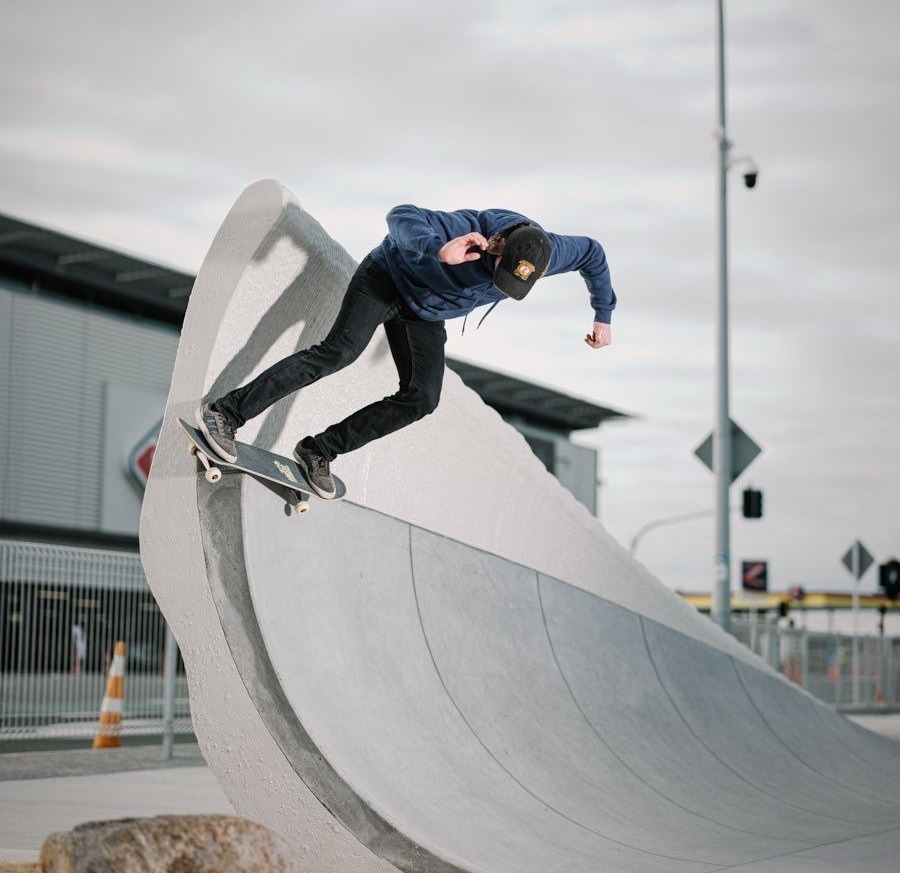Concrete 3D printing company QOROX has constructed a 3D printed skatepark in Tauranga, New Zealand.
The newly opened “Destination Skatepark” features “The Wave.” This 12-meter-long and 3-meter-high structure is reportedly the largest 3D printed skate sculpture in the world.
QOROX fabricated the skatepark, which includes 3D printed quarter pipes, ledges, and supports, using the CyBe RC (Robot Crawler) mobile 3D concrete printer from Dutch additive manufacturing construction firm CyBe.
QOROX also utilized the company’s CyBe Power Pack concrete material mixture. This was combined with QOROX’s Q-Ink mortar, enabling 80% of the material to be sourced locally for a sustainable construction process.
According to Peter Fraser, the council’s design lead for the project, Destination Skatepark is one of the first 3D printed skateparks in the world.
“There are only a small handful of skateparks we know of internationally,” explained Fraser. He added that other 3D printed skate locations don’t offer the size, variety and intricate designs of this new recreational space.

QOROX constructs a new 3D printed skatepark
According to Fraser, Destination Skatepark was made “with the community in mind,” being co-designed with local community members. Designs were refined by QOROX and landscape and garden design specialists Rich Landscapes.
QOROX’s 3D printing capabilities reportedly enabled creative design freedom for forms and textures that would have been impossible or too expensive to achieve using traditional construction methods.
3D concrete printing also improved the affordability and environmental sustainability of the construction process. By 3D printing the skateable strictures, the developers negated the need for complicated and expensive molds.
Sustainability was bolstered by QOROX’s Q-Ink, a blend of essential concrete 3D printing constituents which was mixed with locally sourced low-carbon materials. This combination enabled the park to be constructed with 30% less carbon emissions than traditional concrete.

The CyBe RC 3D printer, used to fabricate the skatepark, is a mobile concrete 3D featuring an ABB robotic arm attached to a crawler with rubber tracks. This manoeuvrability makes it ideal for on-site construction on all terrains. The 3D printer’s stabilizers extend during 3D printing, allowing it to produce structures with substantial heights, such as QOROX’s record-breaking “The Wave”.
The construction of Destination Skatepark is the latest in a long line of 3D printing projects conducted by QOROX. The company claims to be the first to have introduced 3D concrete printing to New Zealand in 2018.
Earlier this year, the company partnered with CyBe to construct the first commercial building in the southern hemisphere featuring 3D printed concrete walls. The textured walls were fabricated in under five hours using CyBe’s RC 3D printer. Construction was completed in just two and a half days with two people.
The two companies followed this with the Southern Hemisphere’s largest 3D printed building, Paremoremo House. With a total area of 252m², the 3D printed house can accommodate a family of four and boasts flood and earthquake resistance, enhancing its climate resilience.

Construction 3D printing’s continued growth
The use of additive manufacturing for construction applications is growing globally, improving the construction speed, sustainability and affordability of buildings and outdoor spaces.
Earlier this year, Swiss construction solutions provider Holcim worked with PERI 3D Construction to construct Switzerland’s first 3D printed building.
The team leveraged COBOD’s BOD2 3D concrete printer to fabricate a 50 m² showroom in just 55 hours over 8 days. The building features 6.2-meter-high curved walls created using a sustainable concrete mix created by Holcim. This blend features reduced cement content and offers superior strength to conventional mortar.
Henrik Lund-Nielsen, Founder and General Manager of COBOD, congratulated Holcim on its 3D printable concrete, highlighting its importance for lowering the CO2 footprint of the construction sector.
Elsewhere, 3D printer manufacturer WASP recently partnered with landscape designer and gardener Giulio Giorgi to construct a sustainable sensory ceramic garden for the RHS Chelsea Flower Show 2024.
At the show, held between 21-25 May, the 3D printed garden received the inaugural RHS Environmental Innovation Award. WASP technology was used to replace concrete structures with 3D printed clay blocks which supported circular raised beds.
These 3D printed terracotta modules can be transported and rearranged to create customizable garden spaces. WASP will make the modules available to purchase from its official online shop.
Register now for AMAA 2024 to hear insights from industry experts on additive manufacturing in aerospace, space, and defense.
Want to help select the winners of the 2024 3D Printing Industry Awards? Join the Expert Committee today.
What does the future of 3D printing hold?
What near-term 3D printing trends have been highlighted by industry experts?
Subscribe to the 3D Printing Industry newsletter to keep up to date with the latest 3D printing news.
You can also follow us on Twitter, like our Facebook page, and subscribe to the 3D Printing Industry Youtube channel to access more exclusive content.
Featured image shows somebody skating “The Wave,” the largest 3D printed skate sculpture. Photo via Tauranga City Council & QOROX.


